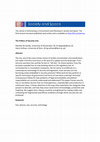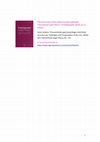Papers by Gavin Sullivan
By laboring underneath the radar of formal law, using a diverse array of conceptual tools and wor... more By laboring underneath the radar of formal law, using a diverse array of conceptual tools and working from material disregarded by mainstream legal scholarship, Fleur Johns' research has consistently opened up novel ways of grappling with international legal problems. The article at the focal point of this symposium continues to push the envelope of international legal studies. It sheds light on how the rise of Big Data and algorithmic decisionmaking is transforming international authority. It also speaks to the increasing deformalization of international law. Examining the mundane practices of global governance may sound unrevealing to some. But Johns shows how this approach can yield important insights into international law's operations and effects.

European Journal of Law and Technology, 2011
This article considers factors that limit or exclude civil society involvement in the regulatory ... more This article considers factors that limit or exclude civil society involvement in the regulatory process for nanotechnologies by critically examining an attempt to mount a public-interest legal challenge against the UK Health and Safety Executive for failing to properly enforce the European Biocidal Products Directive in relation to nanosilver consumer products. The temporal gap between innovation research, knowledge of implications, and regulatory action can often be decades (Owen 2011). Often key stakeholders within civil society are positioned to identify certain relevant problems earlier than governance, regulatory, and investment actors. They might thus limit a dilemma of control(Collinridge, 1984)-where technology at an early stage of development provides opportunities for control but insufficient evidence of impacts to justify or direct control, whereas greater maturity in the development process provides sufficient evidence of impacts but the technology has become 'locked in' after widespread application. One form of intervention in the regulatory process by civil society is litigation. This article critically reflects on the limitations encountered in pursuing a judicial review challenge in the UK between 2008 and 2010. This account highlights some of the structural conditions underlying the contemporary regulatory balance of forces which limit civil society participation (access to legal expertise, resources, scientific knowledge, public awareness, and the regulatory process itself). We also suggest that individuals and civil society organisations thus limited (without meaningful access) may legitimately turn to more explicitly political forms of engagement with nanotechnology. Direct action (as opposed to mediated) is a plausible alternative to regulatory participation and litigation.

Public involvement in the regulatory process for emerging technologies provides a greater diversi... more Public involvement in the regulatory process for emerging technologies provides a greater diversity of perspectives and may thus improve the success of early regulatory discrimination. The case study presented here demonstrates some of the challenges that limit public involvement by critically examining an attempt to mount a public-interest legal challenge against the UK Health and Safety Executive for failure to properly enforce the European Biocidal Products Directive in relation to nanosilver consumer products. While the early stage of developing technologies provides opportunities for regulation there is often insufficient evidence to direct or justify regulatory choices. However, by the time sufficient experience from use of a new technology can direct regulatory measures it may be more difficult or costly to do so because of the now wider integration of the technology into existing infrastructure. This is known as the dilemma of control (Collingridge, 1984). Key stakeholders within civil society are frequently positioned to identify some relevant problems earlier than established governmental, regulatory, and investment actors, thus potentially limiting costs associated with late regulatory intervention. This paper looks at the challenges encountered by civil society publics in pursuing a judicial review challenge in the UK between 2008 and 2010. The examination of correspondence between the regulatory authorities and commercial interests encourages us to consider whether or not pre-existing balancing parameters within regulatory regimes might potentially exacerbate the dilemma of control during periods of rapid innovation.

Our stream invites contributors to analyse the relations between law and security through a tempo... more Our stream invites contributors to analyse the relations between law and security through a temporal lens. What does it mean to rethink in temporal terms the legal conflicts provoked by security politics? Relevant practices for consideration include, but are not limited to: targeted killings, cybersecurity, communications surveillance, global health security, counter--radicalisation and other counter--terrorism measures. In the context of these practices, we invite interdisciplinary panel and paper investigations into the interrelationship of time, technology and security politics. One line of inquiry concerns how securing against uncertain future threats in the present alters the temporal features of law. Another asks how law and time operate together to enable security politics in the first place. We welcome proposals asking whether existing and emerging accountability mechanisms adequately respond to speculative security measures.

The List, one of the most archaic means of written enumeration and classification, has made a for... more The List, one of the most archaic means of written enumeration and classification, has made a forceful recurrence in the post--9/11 global security landscape. From terrorist sanctions lists and No--Fly lists to ''kill--lists'' for drone warfare; from the privately compiled lists of risky banking clients to the regulatory lists of untrustworthy or incompliant companies, the list seems to proliferate as a contemporary technology of security and regulation. How and why are lists becoming newly embedded in security practices? What work do lists perform as specific techniques of government and forms of normative ordering? And what consequences follow for how problems of legal accountability and political responsibility are currently understood and addressed? This paper frames security lists as inscription devices that are heterogeneous, unpredictable and productive in unforeseen ways. It draws attention to the ways they materialise the categories they purport to describe, and how they enact novel forms of knowledge, jurisdiction and targeting. We suggest that critiques could be strengthened by making visible and contesting the fragmented and diffuse conditions through which security lists are produced.

This article examines UN1267 Al--Qaida sanctions regime as a technique of global security listing... more This article examines UN1267 Al--Qaida sanctions regime as a technique of global security listing and form of transnational law with distinct legal ordering processes. Conventional literatures frame these sanctions in formalist terms, flattening their complexity. Understanding their qualities and effects demands a dynamic approach capable of grasping how global law unfolds in each of its constitutive dimensions -normative, temporal and spatial. To that end, this paper develops an analytical framework of transnational legal assemblage and deploys it to examine (i) the proposed changes to EU court rules to enable the handling of secret intelligence and (ii) the fortification of exceptional space for pre--emptive security action. Situating this regime within a contested and emergent field of transnational legal assemblage renders it more variegated and contingent than ordinarily thought, opening up different ways of framing the accountability problems, authority claims, normative conflicts and governance practices of global security law. The rise of the UN Security Council as a global norm--setter in the field of counter-terrorism has been one of the defining features of the post--9/11 security landscape. Yet little analysis has been undertaken as to how the novel field of global security law that has emerged as a result of this shift is legally embedded and institutionally practiced. Broader questions concerning the relationship between the changing nature of the global threat environment marked by accelerated crises and diffuse uncertainty; the emphasis on risk management, pre--emption and speculation as the dominant modalities of executive security governance and the emergence of new forms of intelligence--led international law based on the compilation and implementation of security lists have also received insufficient attention in the academic literature on this issue to date. As such, it currently remains unclear whether attempts to counter the threats of transnational terrorism are facilitating the emergence of distinct transnational legal ordering processes and (if so) what the productive effects of these novel processes might be. This paper seeks to address this problem by examining the UN1267 sanctions regime as a form of transnational law. This regime --which empowers the Security Council to draft a list of individuals and groups deemed associated with Al--Qaeda that all states must implement as sanctions, freezing the assets and banning the travel of those targeted --is ordinarily framed in legal literatures as an abstract, normative phenomenon. This paper goes against this conceptual grain by emphasising the temporal and spatial qualities of the listing regime --temporal not in terms of the regime's historical and legal evolution but rather its specific organising logics of pre--

This article considers factors that limit or exclude civil society involvement in the regulatory ... more This article considers factors that limit or exclude civil society involvement in the regulatory process for nanotechnologies by critically examining an attempt to mount a public-interest legal challenge against the UK Health and Safety Executive for failing to properly enforce the European Biocidal Products Directive in relation to nanosilver consumer products. The temporal gap between innovation research, knowledge of implications, and regulatory action can often be decades (Owen 2011). Often key stakeholders within civil society are positioned to identify certain relevant problems earlier than governance, regulatory, and investment actors. They might thus limit a dilemma of control (Collinridge, 1984) -where technology at an early stage of development provides opportunities for control but insufficient evidence of impacts to justify or direct control, whereas greater maturity in the development process provides sufficient evidence of impacts but the technology has become 'locked in' after widespread application. One form of intervention in the regulatory process by civil society is litigation. This article critically reflects on the limitations encountered in pursuing a judicial review challenge in the UK between 2008 and 2010. This account highlights some of the structural conditions underlying the contemporary regulatory balance of forces which limit civil society participation (access to legal expertise, resources, scientific knowledge, public awareness, and the regulatory process itself). We also suggest that individuals and civil society organisations thus limited (without meaningful access) may legitimately turn to more explicitly political forms of engagement with nanotechnology. Direct action (as opposed to mediated) is a plausible alternative to regulatory participation and litigation.
Media Articles by Gavin Sullivan
Public Reports by Gavin Sullivan
Preface "Building peace in permanent war", the title chosen for this ground-breaking report, perf... more Preface "Building peace in permanent war", the title chosen for this ground-breaking report, perfectly illustrates the paradox of terrorist listing and its pernicious impact on contemporary armed conflicts. Intra-state conflicts are asymmetrical in nature, with internationally-legitimised state actors opposing non-state armed groups (NSAGs) -often labelled or legally proscribed as 'terrorist organisations'. National and international blacklisting regimes were allegedly introduced as legal instruments to prevent violent extremists from carrying out terrorist attacks and incentivise a behavioural change towards de-radicalisation.









Uploads
Papers by Gavin Sullivan
Media Articles by Gavin Sullivan
Public Reports by Gavin Sullivan